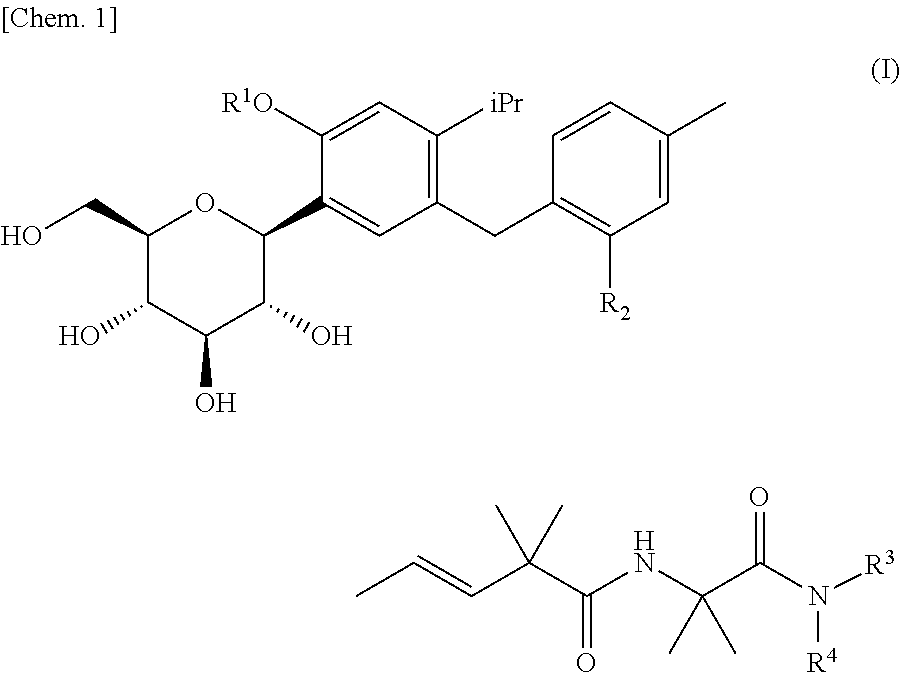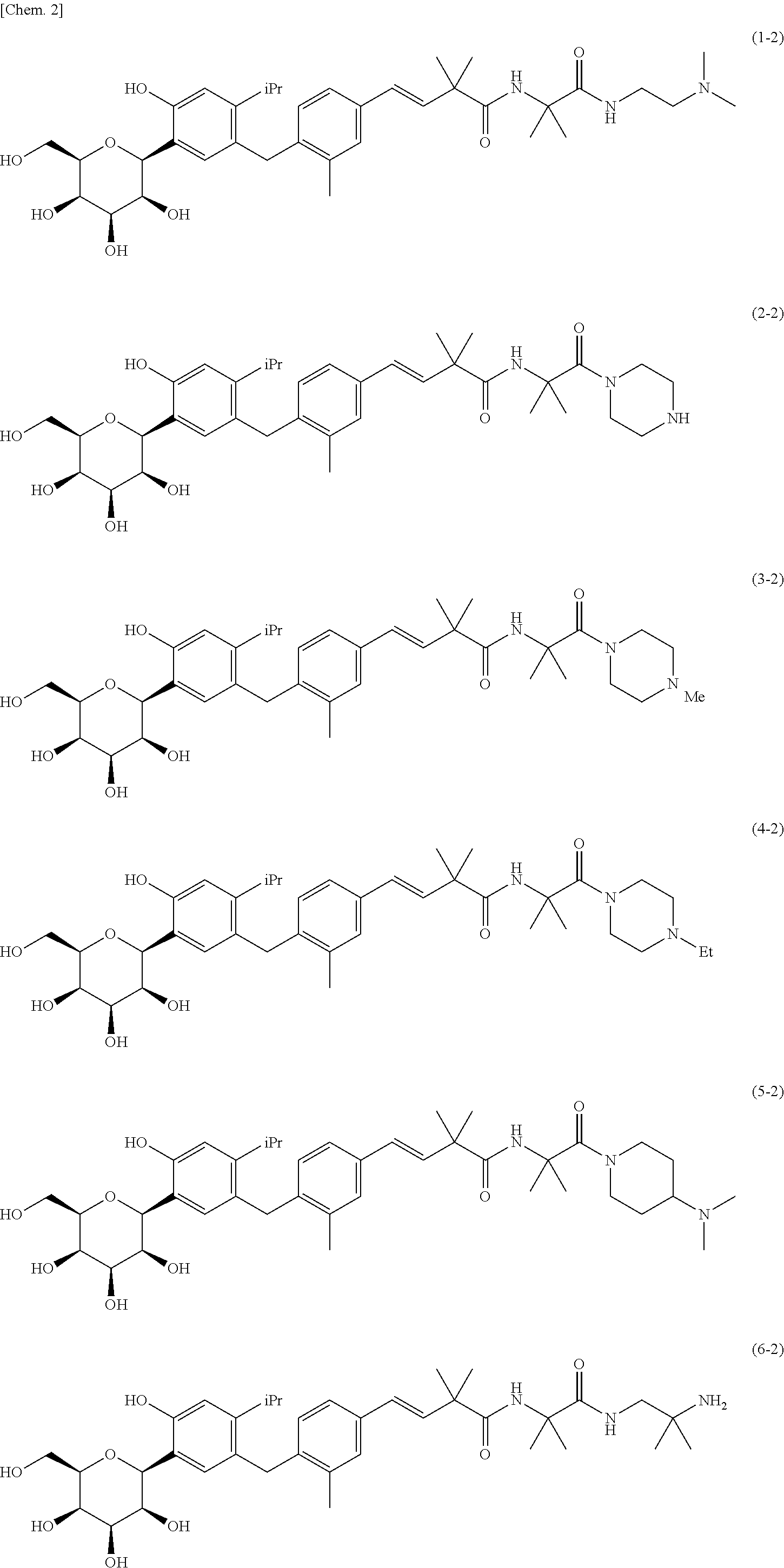4-isopropylphenyl glucitol compounds as sglt1 inhibitors
a technology of sglt1 inhibitor and phenyl glucitol, which is applied in the direction of biocide, drug composition, metabolic disorder, etc., can solve the problems of unexpected toxicity and side effects, and achieve the effect of inhibiting sglt1 activity
- Summary
- Abstract
- Description
- Claims
- Application Information
AI Technical Summary
Benefits of technology
Problems solved by technology
Method used
Image
Examples
reference example 1
Preparation of Intermediate (A)
[0112]
(1) Reference Example 1-1
Compound (A1)
[0113]
[0114]To a solution of 3-isopropylphenol (25.0 g, 0.184 mol) in acetic acid (200 mL), a suspension of potassium iodate (7.88 g, 0.0368 mol) in water (75 mL) and iodine (18.7 g, 0.0736 mol) were added. This reaction mixture was stirred at room temperature for 20 hours. After addition of diethyl ether (400 mL) and water (300 mL), the organic layer was separated. The organic layer was washed with water, saturated aqueous sodium bicarbonate and brine, and then dried over anhydrous magnesium sulfate. After filtering off the desiccant, the solvent was distilled off under reduced pressure and the resulting residue was purified by silica gel column chromatography (hexane:ethyl acetate=95:5) to give compound (A1) (27.6 g, 57%) as a colorless oil.
[0115]1H NMR (200 MHz, CHLOROFORM-d) δ ppm 1.16-1.25 (m, 6H) 2.64-2.98 (m, 1H) 5.21 (s, 1H) 6.57 (dd, J=8.13, 2.20 Hz, 1H) 6.88 (d, J=2.20 Hz, 1H) 7.54 (d, J=8.13 Hz, 1H...
reference example 2
Preparation of Intermediate (B)
[0162]
(1) Reference Example 2-1
Compound (B1)
[0163]
[0164]To a suspension of compound (Al) (27.4 g, 0.104 mol) and potassium carbonate (21.7 g, 0.156 mol) in acetonitrile (200 mL), methyl iodide (9.8 mL, 0.156 mol) was added and stirred at 40° C. for 2.5 hours. Additional methyl iodide (3.5 mL, 0.052 mol) was further added and stirred at the same temperature for 1 hour. Insoluble materials were filtered off, and the filtrate was diluted with ethyl acetate. The organic layer was washed with water, 10% aqueous sodium thiosulfate and brine, and then dried over anhydrous magnesium sulfate. After filtering off the desiccant, the solvent was distilled off under reduced pressure. The resulting residue was purified by silica gel column chromatography (hexane→hexane:ethyl acetate=95:5) to give compound (B1) (24.5 g, 85%) as a light-yellow oil.
[0165]1H NMR (300 MHz, CHLOROFORM-d) δ ppm 1.24 (d, J=6.84 Hz, 6H) 2.87 (sept, J=6.84 Hz, 1H) 3.88 (s, 3H) 6.58-6.65 (m, 1...
reference example 3
Preparation of Intermediate (C)
[0194]
[0195]The same procedures as shown in Reference Examples 1-7 and 1-8 were repeated to give compound (C) (2.26 g) as a light-yellow amorphous substance, except that compound (A6) was replaced by compound (B5), and 4-bromo-2-methylbenzaldehyde was replaced by 4-bromobenzaldehyde.
[0196]1H NMR (300 MHz, CHLOROFORM-d) δ ppm 1.04 (d, J=6.84 Hz, 3H) 1.09 (d, J=6.84 Hz, 3H) 1.76 (s, 3H) 2.01 (s, 3H) 2.05 (s, 3H) 2.06 (s, 3H) 2.91-3.06 (m, 1H) 3.80-3.88 (m, 4H) 3.91 (d, J=5.13 Hz, 2H) 4.06-4.18 (m, 1H) 4.20-4.31 (m, 1H) 4.82-4.93 (m, 1H) 5.15-5.43 (m, 3H) 6.77 (s, 1H) 6.92 (d, J=8.55 Hz, 2H) 7.11 (s, 1H) 7.36 (d, J=8.55 Hz, 2H).
PUM
| Property | Measurement | Unit |
|---|---|---|
| Dimensionless property | aaaaa | aaaaa |
| Dimensionless property | aaaaa | aaaaa |
| Dimensionless property | aaaaa | aaaaa |
Abstract
Description
Claims
Application Information
 Login to View More
Login to View More - R&D
- Intellectual Property
- Life Sciences
- Materials
- Tech Scout
- Unparalleled Data Quality
- Higher Quality Content
- 60% Fewer Hallucinations
Browse by: Latest US Patents, China's latest patents, Technical Efficacy Thesaurus, Application Domain, Technology Topic, Popular Technical Reports.
© 2025 PatSnap. All rights reserved.Legal|Privacy policy|Modern Slavery Act Transparency Statement|Sitemap|About US| Contact US: help@patsnap.com



